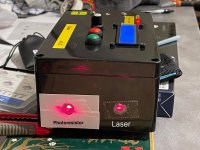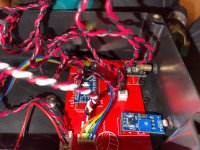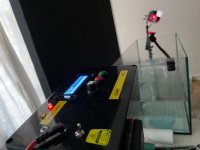sam1902
New member
- Joined
- Dec 18, 2020
- Messages
- 5
- Points
- 1
Hello,
I'm working on a project that requires aiming a laser back to near its source where I placed a photoresistor which senses the laser. When the beam is crossed by a falling object, it triggers an action shortly thereafter. I've already built two functionning iterations of the device but they both use a low power ~5 mW cheap 650 nm laser diode. I power it using an Arduino Nano which has a voltage regulator, itself powered by a 9V battery. You can see what power the current laser diode uses in my other post ( search "How to mesure a laser diode's power ?"). Basically the Arduino can only deliver around 500mA @ 5V.
To use the device, I need to hold and let fall objects right above the beam, but since the beam is invisible, it's hard to know if I'm right above it or not. Something I'd like for the next version would be to be able to see the beam.
The whole setup is indoor, in a dark room, and since there might be 3 people moving around without goggles, it'd be best that this laser diode be safe for eyes (at least reflections of it). Also, the objects might be very reflective (glass, water bottles etc), which is another reason why this should be safe for the eyes. The beam only has to travel around 4 to 5 meters (13ft to 16ft) and should end up with a dot radius of around 6 mm (0.23 inches) thereabout, which is more or less the size of the sensor.
I've looked around and apparently blue and green laser are the best for visible beams, but I remember reading a long time ago that "angel blue" (~480nm) lasers were the best for visible beams because they worked best with Rayleigh scattering. Finally, before receiving this recommendation, I must add that using a smoke machine is not an option for various reasons.
From the post entitled "List of Laser Diodes - 21/06/2020", I've concluded that 475 nm to 495 nm diodes are my sweet spot, but I have no clue as to their beam visibility which is my main concern here. Anything under 470nm is great too because I already have eye protection for these (OD4+).
I will add a few pictures of the project setup.
Thanks for taking the time to help me, again..
I'm working on a project that requires aiming a laser back to near its source where I placed a photoresistor which senses the laser. When the beam is crossed by a falling object, it triggers an action shortly thereafter. I've already built two functionning iterations of the device but they both use a low power ~5 mW cheap 650 nm laser diode. I power it using an Arduino Nano which has a voltage regulator, itself powered by a 9V battery. You can see what power the current laser diode uses in my other post ( search "How to mesure a laser diode's power ?"). Basically the Arduino can only deliver around 500mA @ 5V.
To use the device, I need to hold and let fall objects right above the beam, but since the beam is invisible, it's hard to know if I'm right above it or not. Something I'd like for the next version would be to be able to see the beam.
The whole setup is indoor, in a dark room, and since there might be 3 people moving around without goggles, it'd be best that this laser diode be safe for eyes (at least reflections of it). Also, the objects might be very reflective (glass, water bottles etc), which is another reason why this should be safe for the eyes. The beam only has to travel around 4 to 5 meters (13ft to 16ft) and should end up with a dot radius of around 6 mm (0.23 inches) thereabout, which is more or less the size of the sensor.
I've looked around and apparently blue and green laser are the best for visible beams, but I remember reading a long time ago that "angel blue" (~480nm) lasers were the best for visible beams because they worked best with Rayleigh scattering. Finally, before receiving this recommendation, I must add that using a smoke machine is not an option for various reasons.
From the post entitled "List of Laser Diodes - 21/06/2020", I've concluded that 475 nm to 495 nm diodes are my sweet spot, but I have no clue as to their beam visibility which is my main concern here. Anything under 470nm is great too because I already have eye protection for these (OD4+).
I will add a few pictures of the project setup.
Thanks for taking the time to help me, again..






